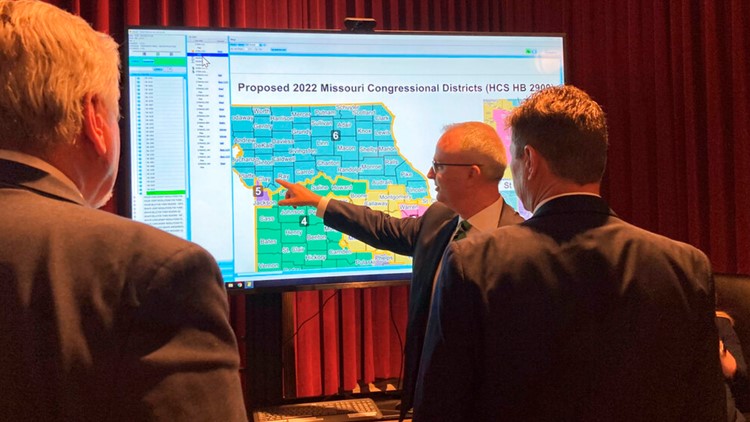JEFFERSON CITY, Mo. — With time running short, the Missouri House on Monday endorsed a newly proposed map for the state's eight congressional districts that — if the Senate agrees — could be used in elections later this year.
The plan embraced by the state House is projected to continue Republicans' 6-2 advantage over Democrats in the state's U.S. House delegation. It marked an attempt to avoid court intervention and break a stalemate with the state Senate before a Friday deadline to pass legislation.
Though Republicans hold large majorities in the state Capitol, Missouri is one of the last states still struggling to enact a congressional redistricting plan based on the 2020 census. Republican factions have been squabbling about how aggressively to draw districts to their favor, and which communities to divide when balancing the population among districts.
Though some remained unsatisfied Monday, a majority voted to advance the new plan.
It's “the best map that we’re going to get at this point,” said Republican state Rep. Dan Shaul, chairman of the House's redistricting committee.
But state Rep. Jerome Barnes, the ranking Democrat on the House’s redistricting panel, said the “map was motivated by partisan purposes and not public input.”
The House first passed a redistricting plan in January. But that stalled in the Senate amid opposition from some conservative Republicans who wanted to tilt it even more to the GOP’s favor. The Senate passed a redistricting plan in March, but the two chambers thus far have been unable to agree on a final version as lawsuits have mounted seeking to compel a new map.
The latest plan appears to strengthen Republicans in the state's only competitive district — suburban St. Louis' 2nd District, held by GOP Rep. Ann Wagner.
To accomplish that while balancing populations, the map splits several communities. One of the most notable divisions is in Columbia, where the southern part and the University of Missouri campus would shifted into 3rd District that stretches eastward toward the St. Louis area. The northern part of Columbia would remain in the 4th District that stretches westward to the Kansas border.
Democratic state Rep. David Smith, of Columbia, called the split “ridiculous” and “absurd."
But Shaul said it was better than a version previously passed by the Senate that would have split apart the university campus.
The House defeated a Democratic amendment that could have given their party a better shot at winning three congressional seats. It also rejected a Republican amendment that could have bolstered the GOP's chances of winning seven seats by splitting Democratic-leaning Kansas City among several Republican-leaning rural districts.
Lawmakers in charge of redistricting in some states have acted aggressively to draw lines to their favor. But that tactic has not always worked out.
New districts are limbo in New York and Kansas, where courts struck down plans enacted by their Democratic- and Republican-led governments, respectively. Lawsuits also are pending against redistricting maps in other states, including Florida and Ohio.
In New Hampshire, the Republican-led Legislature is working on a revised plan after GOP Gov. Chris Sununu pledged to veto the first version it passed.



